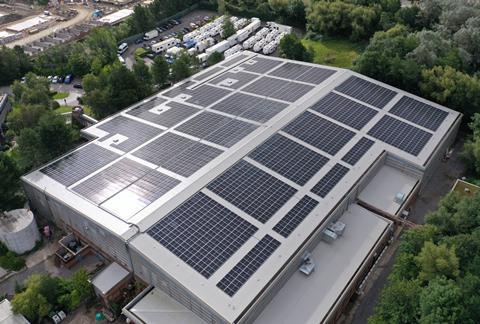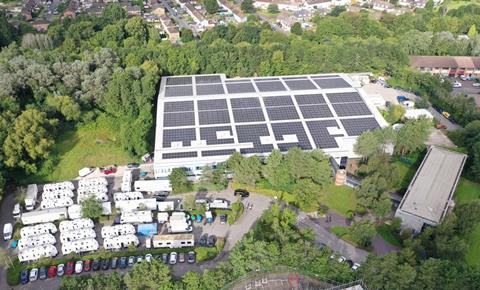Bottle Yard’s business operations manager and sustainability lead Katherine Nash on how community energy could spell new opportunities for studio solar installations

It’s a year since we opened TBY2, The Bottle Yard’s second site. Our £12 million expansion to 11 stages (154,000 sq ft) across two sites has been universally welcomed by productions - but it’s the 1MWp solar array we’ve installed on TBY2’s rooftop that has really got people talking.
Thought to be the largest community-owned rooftop array in the UK and one of the biggest PV installations on any UK studio, it’s been sparking conversations about the bigger role solar could play in the film and television industry’s journey towards a more sustainable future.
The post-Covid ‘race for space’ has increased the total area of studio rooftops in the UK to record levels. At the same time, there’s been an increase in community energy schemes like Bristol Energy Cooperative (BEC) – who funded our array - springing up around the country.
Could this be the perfect time for studios to harness the potential of community energy and become changemakers in clean energy?
Thinking differently
Being a local-authority owned studio, we’ve always had to think creatively about decarbonisation and sustainability. This project was no exception.
We were clear from the outset that solar needed to take centre stage in TBY2’s sustainable design. Bristol Council initially planned a 283kWp array, but BEC came on board with the proposal to fund a bigger installation from their latest share offer – almost four times larger in fact, spanning the entire 66,000 sq ft rooftop.
The result is impressive. 2,380 panels capable of generating enough energy to run 250 average households per year. That’s an annual carbon saving of 200 tCO2e. It’s also more than enough to power the facility, so during peak conditions, TBY2’s surplus power will be ‘sleeved’ to other council-owned buildings via Bristol City Leap, an exciting new project that will enable Bristol Council to source renewable energy from local generators like BEC, via long-term Power Purchase Agreements (PPA’s).
So TBY2’s array not only benefits production filming at the sustainable facility, it will also help the city of Bristol reach its goal to be carbon neutral and climate resilient by 2030.
How it works
We’re often asked how the energy journey works in practice. For TBY2 to have been ‘off grid’ would have been impractical for obvious reasons. Studios can’t risk power outages or ask productions to ‘cap’ energy usage for unforeseen reasons. On-site battery storage was not included in the original project (but has not been ruled out as a future development).
Like most innovations that break the mould of what’s been done before, the new infrastructure needed for the sleeving has taken time and collaboration to put in place and is rolling out in stages.

For the first year, exported energy from TBY2’s array has been sold through a traditional PPA to Younity (who also provided an essential Community Energy Kickstart bridging loan for the array’s purchase). Bristol Council has bought back the energy used from the grid via a PPA. Of this grid power, 82% was from the Council’s green generation sources (like TBY2), and 18% has been topped up from the grid through a traditional energy tariff.
In December, this will change to a sleeved PPA arrangement that will provide a virtual connection between TBY2’s solar installation and Bristol Council’s wider estate, increasing the Council’s green energy generation and reducing grid top up further.
This is a precursor to the full sleeved pool, due to launch in 2024 in conjunction with Bristol City Leap; a world-first, city-level partnership that will bring in over £1bn of investment to transform the way that Bristol generates, distributes, stores and uses energy. Under the full sleeved pool, the surplus power from TBY2 will contribute to a larger pool of renewable energy, shared across a larger group of customers including TBY2 itself.
Community energy potential
It’s not hard to see why community energy is on the rise. Faced with the climate crisis, many of us experience feelings of powerlessness that can be overwhelming. Add to this the rise in energy costs and the situation can appear bleak.
Rather than drift into despair, community energy schemes give people the chance to invest - in BEC’s case, anything from £100 to £100,000 - to contribute to real change in their local community. According to Community Energy England, projects like BEC’s had a total installed capacity of 331 MW in 2021, with 495 different groups helping to save £3.35m from people’s energy bills.
When these groups work hand-in-hand with local authorities, the commercial sector, financiers and network providers, serious potential can be unleashed, with benefits going further than you think.
BEC provides a 5% return on investment for its shareholders and also channels a proportion of profits into local energy projects via its community benefit fund. Grants of up to £5,000 go towards grassroots activities like fuel poverty advice and installing energy efficient lighting in schools.
Where next?
Bristol is well known for its ‘green’ track-record; it was the UK’s first European Green Capital in 2015 and the first council to declare a climate emergency in 2018. So it’s little surprise that the UK’s first community energy partnership with a film studio has been realised here.
Not every city has a City Leap project on the horizon. But with community energy gaining momentum around the UK, what’s to stop more community-owned solar arrays being installed on other studio rooftops?
If every studio interested in rooftop PV reached out to its local community energy scheme today, who knows what might be possible?

Katherine Nash is Bottle Yard’s business operations manager and sustainability lead







No comments yet